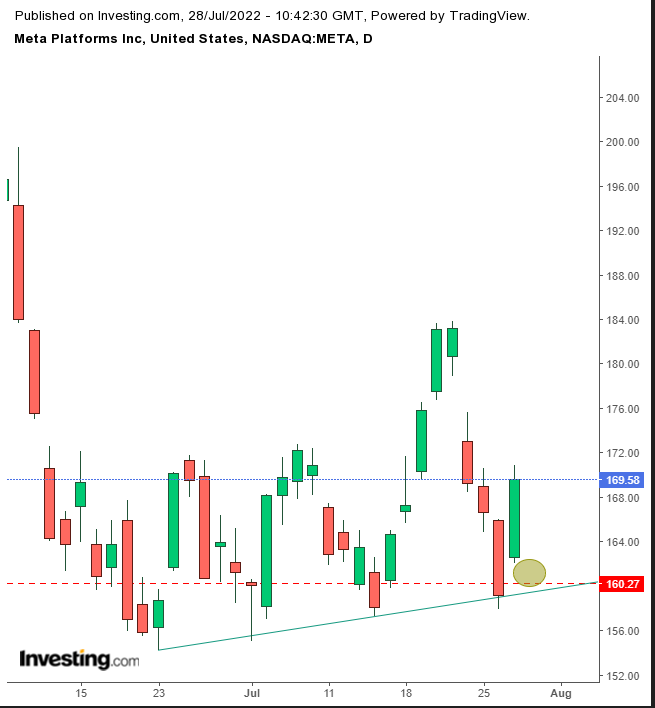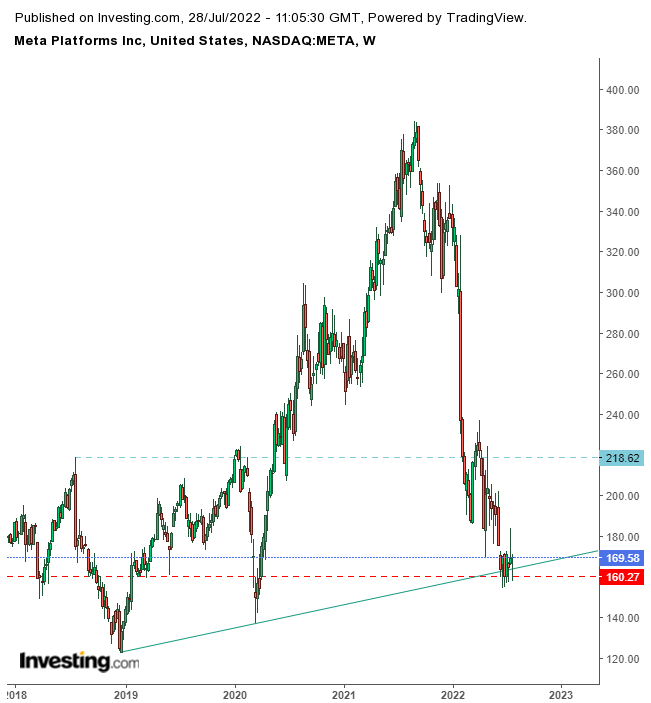Meta Platforms (NASDAQ:META) posted a quarterly sales decline for the first time in its history. Net income also plummeted 36%. The culprit was a reduction in digital advertising across its social media networks including Facebook and Instagram.
The social media giant's revenue fell to $28.82 billion in Q2, short of the expected $28.94 billion. Moreover, management reduced future guidance, forecasting a second straight quarter of declining sales. Disappointed traders increased offers, pushing the stock down 4% in after-hours trading, and the stock fell further in premarket trading to a 5.5% loss.
While all of this is bad news, it does not necessarily mean that the stock price will continue to tumble. And if it falls further, will it necessarily slide right away? FB is down 46% year-to-date and is 58% lower than its Sept. 1, 2021, all-time high.
Does no one think that this could potentially be a buying dip? Let's see if we can figure out traders' behavior by examining the chart.

At the time of writing, the premarket price is $160.70, having rebounded from $161.26. The dotted red line is where the price was, where demand increased, smack at the bottom of its rising trend line since the June 23 low. Let's take a step back and see if we can get some context.

The short-term support jives with the uptrend line since the December 2018 bottom, when US stocks suffered their worst Christmas Eve on record and reached the brink of a bear market.
That synchronized short- and long-term support could be a convenient bouncing board for bargain hunters. Beware, though, that the stock could fall below these trendlines. They simply provide guide posts.
Even if the stock bounces off these rising support lines, it could decline, forming a massive H&S top, which I've been tracking. Either way, from a risk-reward perspective, this is an exceptional trade.
Trading Strategies
Conservative traders should wait and either buy after the stock makes new highs, which will almost certainly not happen until the next bull market or for the long-term top to complete.
Moderate traders would wait for the price to register a peak higher than the $183.85, posted on July 21, than for a buying dip to increase the odds for a short-term uptrend.
Aggressive traders could enter a contrarian trade, provided they accept the higher risk proportionate to the higher reward of beating the market. Sound money management is crucial. Here is a generic example:
Trade Sample - Aggressive Long Position:
- Entry: $160
- Stop-Loss: $157
- Risk: $3
- Target: $172
- Reward: $12
- Risk-Reward Ratio: 1:4
Author's Note: I am not in the fortune telling business. I am analyzing the technical conditions and providing a prognosis. Trading is a statistics-based initiative. The objective is not to win any one trade but to manage your capital so that you can make it to the winning trades when you catch up to statistics. So, before you enter this trade, close your eyes and imagine it lost. If you can't handle that, do NOT enter the trade. Operating according to a plan that incorporates your timing, budget, and temperament will take you to the next level. Until you learn how to do that, you can practice with my generic samples for educational purposes, not profit. Or, you'll end up with neither. Guaranteed. No money back.
